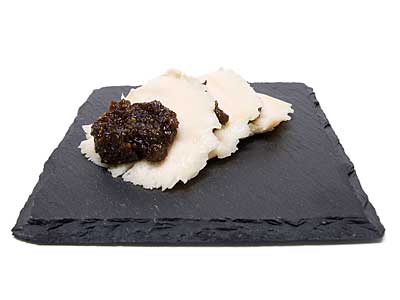July 2, 2012
Amuse-Bouche

copeaux de poulet
(chicken sandwich)
Your Honor, I rise to speak on behalf of the much-maligned boneless, skinless chicken breast. For years, people have described it as tasteless cardboard or as the Wonder Bread of protein. I would like to suggest that the problem lies not with this fine piece of galline substance, but with those to deign to denature its proteins and then ascribe their short comings to the basic nature the core material. Your Honor, I would suggest that the boneless, skinless chicken breast is not among the lowest, but the highest form of comestible.
Anyone who has ever eaten raw chicken-breast meat, myself included, describes the taste as sweet. So why isn’t cooked chicken-breast meat sweet? Most people overcook it. Worse, they don’t overcook it a little, they nuke it. Why does the USDA suggest that mammalian protein be cooked to 63 °C (145 °F) but chicken breasts to be cooked to 74 °C (165 °F)? Is chicken protein that much different from mammal protein? No, the USDA acts just as ignorant of how bacteria exists in whole muscle meat as the average person. Some say it’s politics not science.
The bacteria of concern—salmonella, Escherichia coli, listeria monocytogenes, campylobacter jejuni—all are surface bacteria. They reside on the surface, not the interior of the meat. Pasteurization of the surface is a matter of time and temperature. At 74 °C (165 °F), all the aforementioned bacteria die instantly. At lower temperatures, down to a point, the bacteria will die after sufficient thermal exposure. If the meat is being seared, then the surface will see instant kill temperatures, and the muscle can be served without further cooking. Think seared tuna. (In Berkeley, Ippuku serves a chicken tartar where the surface of the chicken breast is seared quickly before dicing. It’s quite good.) With all this in mind, why does chicken have to be cooked to a higher temperature than beef? I think it’s irrational fear.
Towards the end of my previous life, I had occasion to have a beer with an FDA employee who was also close to making a life change—we both were leaving our jobs. At one point in her FDA career, she worked in the food safety division, and she described how most consumer food safety decisions were based on politics rather than science. The time-temperature relationship of pasteurization was considered too complicated for the average consumer—isn’t the average American conversant with partial differential equations?—so simplified rules were adopted. On top of the reality of the science, the FDA had to factor in the consumer’s unhygienic practices, incompetence with a thermometer, and inclination to sue. Thus, food safety guidelines are born.
And so Your Honor, I submit that the boneless, skinless chicken breast is a paradox. People complain that it is no better than tasteless cardboard, but the same people overcook it; they thus create the vary-same tasteless cardboard they complain about. I submit for your enjoyment, Exhibit One, a piece of boneless, skinless chicken breast cooked to a temperature of 57 °C (135 °F). The meat was cooked using a low-temperature cooking technique so no part of it exceeded the final temperature, but it was held at that temperature long enough to pasteurize it. The meat is sweet and succulent. You can see by the texture that the meat is cooked. The color is white with a slight pink tinge, a nuance that will disappear after a few moments exposure to oxygen. Have a bite.
In conclusion, since boneless, skinless chicken breasts are so often compared to white bread, why not slice the meat into slices like bread. And like bread, why not smear each slice with a little jam. In Exhibit Two, the “jam” is dried figs that have been soaked in brandy overnight, minced, cooked with sugar until soft, and pureed. I’m sure Your Honor will agree that the combination is quite tasty.
450 g (1 lb)
dried figs, diced
120 ml (1⁄2 c)
brandy
125 g (5⁄8 c)
granulated sugar
1 half
boneless, skinless chicken breast
1. To make the fig paste: Soak the figs in the brandy overnight, or until soft.
2. Place the figs and brandy, along with the sugar, in a saucepan, and simmer until quite soft. Puree thoroughly with a food processor. Refrigerate until needed.
3. Cut a 3-cm (1-1⁄4-in) wide strip from the breast along the area where it was attached to the sternum—that’s the long edge. Reserve the rest of the breast for other purposes. Season the strip with a little fine salt and place in a plastic bag. Vacuum seal the bag. Cook the breast in a water bath until the internal temperature reaches 57 °C (135 °F).
4. As the breast approaches being done, reheat the fig paste in a saucepan, and keep warm.
5. Remove the breast from the bag and discard any juices. Thinly slice the breast on the bias, and place three pieces, layered with a smear of the fig paste, on each serving plate.
6. Serve immediately.
Yield: 4 servings.
© 2012 Peter Hertzmann. All rights reserved.
